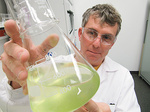Sound solution to blue-green algae problem
 Science Science
University of Adelaide researchers are investigating the use of ultrasound as an environmentally friendly and cheaper alternative to controlling blue-green algae in our fresh water supplies. In collaboration with water industry organisations including SA Water, the researchers are starting a three-year project to find the best process for using ultrasound in large volumes of water to combat this significant world-wide water quality problem. Chief Investigator Dr Carl Howard, from the University's School of Mechanical Engineering, said researchers will be testing different amplitudes and frequencies of ultrasound. "We've already shown in laboratory tests that ultrasound is effective at neutralising blue-green algae," Dr Howard said. "We know it works but we don't yet know the best frequencies, amplitudes and duration for the most effective, economic and efficient process." Blue-green algae (or cyanobacteria) can affect health and causes other water quality and environmental problems when it accumulates and forms 'blooms' in fresh water. It is currently controlled by the application of chemical treatments. Dr Howard said ultrasound - at high amplitudes - was used for treating sewage and in other chemical processes but was not practical for fresh water treatment. Ultrasound at high amplitudes breaks down the cell walls of the blue-green algae, releasing toxins into the water. "The novel part of our solution is that we will be using ultrasound at low amplitudes where it immobilises the blue-green algae without releasing its toxins into the water and with lower energy input," Dr Howard said. The researchers propose mounting ultrasound generators inside large underwater columns containing mixers, which will draw the water through for treatment as it flows past. The main industry partner, SA Water, has been working with University of Adelaide researchers over the past 15 years on a range of chemical and water circulation techniques in reservoirs and the River Murray to help tackle this problem. "This project is an innovative and exciting development in this area of research, which has the potential to provide many benefits to drinking water supplies both locally and nationally," said SA Water Biology Research Leader Associate Professor Mike Burch. Other industry partners are Melbourne Water Corporation, United Water International Pty Ltd, Water Corporation of WA and Water Quality Research Australia. The project has been granted $400,000 under the latest round of the Australian Research Council's Linkage Projects scheme. More than $2.5 million in total funding was provided for nine new industry-linked projects at the University of Adelaide, spanning the fields of health, environment and ecology, mining, engineering and communications. The winning projects will also collectively receive almost $4.8 million in cash and in-kind contributions from collaborative partners. Story by Robyn Mills
For more information about industry-linked research visit Open Day Sunday 15 August. www.adelaide.edu.au/openday
|





